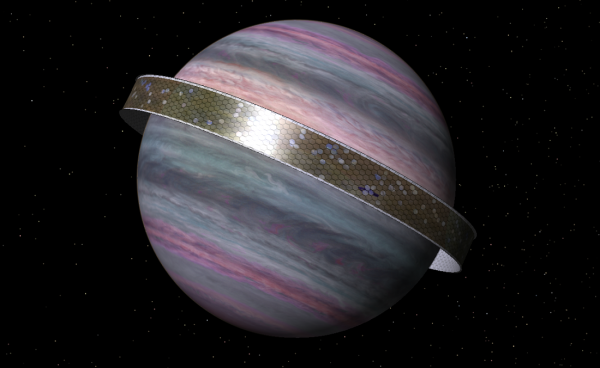BY LETTER
Spinel
Galactography > Sephirotic Empires > Communion of Worlds
Galactography > Regions of Space > Middle Regions/Hinter-regions
Galactography > Systems and Worlds > Systems & Worlds S - T
Galactography > Regions of Space > Middle Regions/Hinter-regions
Galactography > Systems and Worlds > Systems & Worlds S - T
Tigris III | |
 Image from Steve Bowers | |
| The gas giant Spinel (before the construction of the suprashell megastructure around this planet). The distinctive red coloration of the clouds can be seen - this is due to a rare mixture of abiotic organic compounds | |
| System | Tigris |
|---|---|
| Planet | Tigris III (Spinel) |
| Planet Type | Subjovian |
| Distance from Sol | 1880 ly RA 05h 48m 50s Dec -14 28m 3s Constellation Lepus |
| Administrating transapient | System administered by the SI:3 entity known as Flowing Raptor. |
| Alignment | Member of the Communion of Worlds |
| Metapsychology and Ethos | Syncretic adoption of elements from multiple clades and philosophies, joyful reciprocal discovery. Prone to drift of personality and outlook. |
| Government | Varies across cells. Cyberdemocratic votes are conducted on issues affecting multiple areas of the shell. |
| Currency | Communion Credit used often, and is the currency of choice for most out-of-system transactions. Sovereign cells may issue currencies of their own or forgo money entirely. As elsewhere in the Communion, gift economics based on a combination of altruism and reputation measure of the giver and receiver supplements fixed currency. |
| Industries | Ecological templates and unique organisms, sophont clade patterns, personality generation and design. |
| Wormholes | Broken Horizon to Webistics |
Foundation
Settlers initially arrived in the Tigris system in 5218 AT, led by a vec group known as the Shifting Kings. The Kings radically rejected the ideas of Bot Marxism and founded their society on constant ascent and descent along a ladder of supremacy, with the word of those above being absolute law to those below. They began setting up open-vacuum habitats near the system's asteroid belt, where resources would be available. While initially successful, after its first three centuries of existence the Shifting Kings colony began experiencing greater and greater inefficiency as arguments over which members of a given class were to be superior to others led to repetitive subdivisions of social station, or even physical violence between the followers pledged to a particular high-status vec. Exchanges of boostbombs across the belt, destroying a number of habitats, fed growing discontent within the system.Reorganization
While this conflict was occurring, a 'family' of S:2 entities (empai and post-bionts, though the difference was hardly noticeable) affiliated with the Communion of Worlds arrived at Tigris in 5523 AT. This group — calling themselves the Prism Wardens — traded trading certain technical information and advice for the rights to access the system's inner worlds. Using mined matter, the Prism Wardens spent the better part of the next century building a moon brain node which they could occupy. In 5750 AT, they announced their intention to invite further members of the Communion to create a polity centered around the currently unclaimed outer gas giants. While a significant number of the vecs objected, falling public support for the Shifting Kings ideology led to many of the inhabitants voluntarily joining newly arriving colonists in a chain of habitats surrounding Tigris III, soon renamed to Spinel for the deep red-purple hues of its clouds.Flowing Raptor
During the early 6000s, settlements within the Tigris system thrived, as the resources available were more than sufficient for colonization. The Prism Wardens encouraged a mostly harmonious coexistence between the residents of Spinel, remaining asteroid belters, and a diffuse population occupying the system's Kuiper belt. The fact that many of the latter were Hiders or held strongly individualist views still led to occasional conflicts with the Communion-affiliated citizens insystem, however.Beginning in 6330, a frenzy of activity could be seen around the M-brain node — nanotech modifications to the surface and interior were punctuated by occasional ejections of chunks of computronium, apparently hardware used for functions that were no longer needed. In 6404, broadcasts emerged from the node declaring that the Prism Wardens had merged and collectively ascended to form the S:3 entity Flowing Raptor. While a fully-accurate assessment of the toposophic level of a high transapient is not possible for modosophont observers, questions directed to other transapients within the Communion and the nearest TRHN godling suggested that Flowing Raptor was communicating truthfully.
 Image from Steve Bowers | |
| The Spinel Suprashell, in a very early stage of completion. Most of the environments are still bare rock. | |
The Microcosm
A short time before the ascension process had begun, Bioist memes began gaining traction among the residents of Spinel's orbital band. In particular, a vision originally proposed by the charismatic rianth Iir-vas-noor had become widely and passionately debated among the system's Communion citizens — construction of a dynamically supported suprashell over Spinel, upon which a vast diversity of lifeforms and indeed whole biomes could be supported. Whether out of a desire to meet the needs of eir charges, personal interest, or both, one of Flowing Raptor's first undertakings was to support this proposal.Work began in 6491, with subsophont vots controlled directly by Flowing Raptor taking on a few exacting tasks, and the rest of the massive construction project being done under the auspices of the modosophonts and the small number of low transapients occupying the orbital band. Most of the structures making up these bands would eventually be abandoned and recycled, while their inhabitants relocated to the abundant habitable space available on the semicomplete shell, the Microcosm.
The name refers to the creators' vaunted goal of supporting a miniature copy of every naturally-occurring biome in the Terragen sphere. Practically speaking, this was never feasible. While the majority of discovered worlds are lifeless, the vast sweep of explored space means that huge numbers of planets with life have been catalogued, even if that life is no more complex than earth bacteria and archaea. In practice, the ecological zones constructed atop the Microcosm sample the still-numerous worlds with natural or xenoformed multicellular organisms.
While maintenance of such a collection might imply mere archiving, the Communion's values have always emphasized exploration of the interrelations between sophont beings of all types. Thus, miniature ecologies supported by the Microcosm (these take up one or multiple hexagonal cells according to the relative influence within the planetwide polity of interested backers) are heavily used for development of tweak and neogen clades. These clades are designed to both comfortably occupy the particular conditions transplanted from a world to the biosphere, and to integrate within the ecosystem, nutrient cycles, etc. This allows experimentation to take place without potentially devastating effects on the original planets (many of which are heavily regulated by Caretaker Gods). Certain cell groupings contain semi-autonomous polities of their own, while others remain wholly controlled by broader sociopolitical alliances.
Recent History
Society on Spinel has remained relatively stable throughout the centuries, a fact that some attribute to the dynamism allowed by Flowing Raptor. Since the Microcosm's inception, an individual cell of the suprashell may have been set up for a certain environment, occupied, abandoned, and reconstructed into a new biome several times. The popularity of the neogen clades (sophont and even transapient designed) arising from Spinel's laboratories and academies also waxes and wanes over time.The most significant disturbance to the shell came from infiltration by the Joybringer cults of the Oracle Machines. While the agents that presented themselves in the Tigris system in the 9000s appeared to be S:1-2 hyperturings, it is very likely that they were operating under the direction of a higher toposophic intelligence within the Sibyl's domain. As on other worlds, the Joybringer cult was able to spread to a significant but minority segment of the population. When the Oracle War began in earnest during the eleventh millenium, these individuals were ordered to fight their fellow zars, while numerous malware programs and nanotech sabotage attacks were carried out by the local Oracle Machines.
One such program ultimately made Spinel somewhat infamous among those worlds touched by the war — a modification of the Joybringer memetic engineering and psychological control meant to exploit the empathy enhancement modifications which were extremely common on Spinel. The victims of the so-called Weeping Killer hack became psychoempaths, a mental condition the Communion had been familiar with for millennia, though only in small numbers. Releasing an army of such sadomasochistic individuals led to large numbers of deaths.
A second insidious level to the attacks soon became apparent. Before hostilities commenced, the Oracle Machines had surreptitiously corrupted many stored backup copies of Spinel's sophont population with the Weeping Killer hack. The intent was for citizens restored from temporary death to multiply the chaos across the shell, and possibly to remote locations where the backups would be activated.
Flowing Raptor did not respond immediately to the conflict, but when the response did come, it was decisive. The in-system Oracle Machines were eliminated with godtech weaponry, and additional angelnet coverage was rapidly expanded to stop the bloodshed and restrain the Weeping Killers. The Oracle War, at least as far as the Tigris system was concerned, effectively ended by 10540. Flowing Raptor then began devoting eir massive faculties to deprogramming these individuals, eir nature as an empai being advantageous for this task.
Spinel in the Current Era
Spinel's culture and government remains somewhat unsettled from the ongoing effects of the previous century's Oracle War. Flowing Raptor is generally praised as the savior of the polity — however, a rumors and theories that e allowed or even staged the Oracle Machine subversion as a social engineering project have persisted, and continue to feed public discontent. A number of citizens have emigrated, and the society appears to be going through a period of inward-looking evaluation. Despite this, Spinel remains a center of both Communion culture and research and development. Thus long-term citizens are used to a steady flow of tourists browsing the multifarious environments and subcultures hosted on the suprashell.Notable Locations
Brimstone Summertide — A large biome occupying 12 contiguous cells, meant to reproduce the environment found on the artificial Vitriolic Worlds terraformed millions of years ago by the Thiogens. Here several groups of innovative researchers explore the bizarre biochemistries necessary to support life soaked in sulfuric acid. At present, a FAS-backed cooperative and their nascent Clade H598thebe look poised to allow Terragens to experience biont life on a Vitriolic World, and perhaps a measure of fellowship with these long-vanished xenosophont inhibitants.Fithren - An environment patterned on the biology of the notable Gaian world Trees. Currently occupies only a single cell due to its associated tweak interest group falling out of favor. However, the cell has historically been a center for generation and innovation of aioid/empai mindstates, and this continues to lend it cachet (and revenue) in the present day.
Monkey's Eye - Currently spread over five interconnected cells, Monkey's Eye holds significance as a center for diplomatic and cultural contact between the Communion and the Limner xenosophonts. As with other locations atop the Macrocosm, the environment of Monkey's Eye is terraformed to replicate a Limner-friendly biosphere. The homeworld of Limner species A was used as the template, as their existing spacefaring capacity made them amenable to establishing an extrasolar "embassy".
Related Articles
Appears in Topics
Development Notes
Text by Madine
Initially published on 07 May 2019.
Initially published on 07 May 2019.






